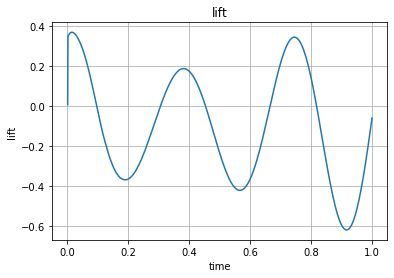This page was generated from unit-3.2-navierstokes/navierstokes.ipynb.
3.2 Incompressible Navier-Stokes equations¶
We are solving the unsteady Navier Stokes equations
Find \((u,p):[0,T] \to (H_{0,D}^1)^d \times L^2\), s.t.
[1]:
from netgen import gui
from ngsolve import *
from netgen.geom2d import SplineGeometry
Schäfer-Turek benchmark¶
We consider the benchmark setup of from http://www.featflow.de/en/benchmarks/cfdbenchmarking/flow/dfg_benchmark2_re100.html . The geometry is a 2D channel with a circular obstacle which is positioned (only slightly) off the center of the channel. The geometry: 
The viscosity is set to \(\nu = 10^{-3}\).
[2]:
from netgen.geom2d import SplineGeometry
geo = SplineGeometry()
geo.AddRectangle( (0, 0), (2, 0.41), bcs = ("wall", "outlet", "wall", "inlet"))
geo.AddCircle ( (0.2, 0.2), r=0.05, leftdomain=0, rightdomain=1, bc="cyl")
mesh = Mesh( geo.GenerateMesh(maxh=0.08))
mesh.Curve(3); Draw(mesh)
# viscosity
nu = 0.001
Taylor-Hood velocity-pressure pair¶
We use a Taylor-Hood discretization of degree \(k\). The finite element space for the (vectorial) velocity \(\mathbf{u}\) and the pressure \(p\) are:
[3]:
k = 3
V = VectorH1(mesh,order=k, dirichlet="wall|cyl|inlet")
Q = H1(mesh,order=k-1)
X = FESpace([V,Q])
The VectorH1 is the product space of two H1 spaces with convenience operators for identity, grad(Grad) and div.
Stokes problem for initial values¶
Find \(\mathbf{u} \in \mathbf{V}\), \(p \in Q\) so that
with boundary conditions:
the inflow boundary data ('inlet') with mean value \(1\)
"do-nothing" boundary conditions on the ouflow ('outlet') and
homogeneous Dirichlet conditions on all other boundaries ('wall').
[4]:
gfu = GridFunction(X)
velocity = gfu.components[0]
Draw(velocity,mesh,"u",sd=3)
Draw(gfu.components[1],mesh,"p",sd=3)
from ngsolve.internal import visoptions
visoptions.scalfunction = "u:0"
# parabolic inflow at bc=1:
uin = CoefficientFunction((1.5*4*y*(0.41-y)/(0.41*0.41),0))
gfu.components[0].Set(uin, definedon=mesh.Boundaries("inlet"))
Redraw()
inflow profile plot:¶
[5]:
import matplotlib; import numpy as np; import matplotlib.pyplot as plt;
%matplotlib inline
s = np.arange(0.0, 0.42, 0.01)
bvs = 6*s*(0.41-s)/(0.41)**2
plt.plot(s, bvs)
plt.xlabel('y'); plt.ylabel('$u_x(0,y)$'); plt.title('inflow profile')
plt.grid(True)
plt.show()

To solve the Stokes (and later the Navier-Stokes) problem, we introduce the bilinear form:
[6]:
(u,p), (v,q) = X.TnT()
a = BilinearForm(X)
stokes = (nu*InnerProduct(grad(u),grad(v))-div(u)*q-div(v)*p)*dx
a += stokes
a.Assemble()
f = LinearForm(X)
f.Assemble()
inv_stokes = a.mat.Inverse(X.FreeDofs())
res = f.vec.CreateVector()
res.data = f.vec - a.mat*gfu.vec
gfu.vec.data += inv_stokes * res
Redraw()
IMEX time discretization¶
For the time integration we consider an semi-implicit Euler method (IMEX) where the convection is treated only explicitly and the remaing part implicitly:
Find \((\mathbf{u}^{n+1},p^{n+1}) \in X = \mathbf{V} \times Q\), s.t. for all \((\mathbf{v},q) \in X = \mathbf{V} \times Q\)
with
and
We prefer the incremental form (as it homogenizes the boundary conditions):
[7]:
dt = 0.001
# matrix for implicit part of IMEX(1) scheme:
mstar = BilinearForm(X)
mstar += InnerProduct(u,v)*dx + dt*stokes
mstar.Assemble()
inv = mstar.mat.Inverse(X.FreeDofs())
conv = LinearForm(X)
conv += InnerProduct(grad(velocity)*velocity,v)*dx
Instead of assembling a LinearForm in every time step, one could use an operator application of a BilinearForm, see unit-2.11 or the next unit.
[8]:
t = 0
tend = 0
[9]:
# implicit Euler/explicit Euler splitting method:
tend += 1
while t < tend-0.5*dt:
print ("\rt=", t, end="")
conv.Assemble()
res.data = a.mat * gfu.vec + conv.vec
gfu.vec.data -= dt * inv * res
t = t + dt
Redraw()
t= 0.9990000000000008
Supplementary 1: Computing stresses¶
In the previously used benchmark the stresses on the obstacle are evaluated, the so-called drag and lift coefficients.
The force acting on the obstacle is
The drag/lift coefficients are
where \(\bar{u} = 1\) is the mean inflow velocity and \(L = 0.41\) is the channel width.
We use the residual of our discretization to compute the forces. On the boundary degrees of freedoms of the disk we overwrote the equation by prescribing the (homogeneous) boundary conditions. The equations related to these dofs describe the force (im)balance at this boundary.
Testing the residual (functional) with the characteristic function on that boundary (in the x- or y-direction) we obtain the integrated stresses (in the x- or y-direction):
We define the functions which are characteristic functions (in terms of boundary evaluations)
[10]:
drag_x_test = GridFunction(X)
drag_x_test.components[0].Set(CoefficientFunction((-20.0,0)), definedon=mesh.Boundaries("cyl"))
drag_y_test = GridFunction(X)
drag_y_test.components[0].Set(CoefficientFunction((0,-20.0)), definedon=mesh.Boundaries("cyl"))
We will collect drag and lift forces over time and therefore create empty arrays
and reset initial data (and time)
[11]:
time_vals = []
drag_x_vals = []
drag_y_vals = []
[12]:
# restoring initial data
res.data = f.vec - a.mat*gfu.vec
gfu.vec.data += inv_stokes * res
t = 0
tend = 0
With the same discretization as before.
Remarks: * you can call the following block several times to continue a simulation and collect more data * note that you can reset the array without rerunning the simulation
[13]:
# implicit Euler/explicit Euler splitting method:
tend += 1
while t < tend-0.5*dt:
print ("\rt=", t, end="")
conv.Assemble()
res.data = a.mat * gfu.vec + conv.vec
gfu.vec.data -= dt * inv * res
t = t + dt
Redraw()
time_vals.append( t )
drag_x_vals.append(InnerProduct(res, drag_x_test.vec) )
drag_y_vals.append(InnerProduct(res, drag_y_test.vec) )
#print(drag)
t= 0.9990000000000008
Below you can plot the gathered drag and lift values:
[14]:
# Plot drag force over time
plt.plot(time_vals, drag_x_vals)
plt.xlabel('time'); plt.ylabel('drag'); plt.title('drag'); plt.grid(True)
plt.show()

[15]:
# Plot lift force over time
plt.plot(time_vals, drag_y_vals)
plt.xlabel('time'); plt.ylabel('lift'); plt.title('lift'); plt.grid(True)
plt.show()
